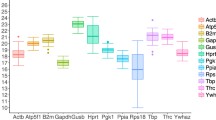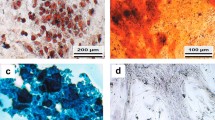Abstract
Quantitative real time reverse transcription PCR, qRT-PCR, is one of the most important techniques for assessing the level of gene expression. Selecting the correct reference gene to normalize the results is a key step in this method. Inaccurate data can be generated if the correct reference gene is not selected. The level of the expression of reference genes is tissue-variable, and in the case of mesenchymal stem cells (MSC), it can be different depending on the source of their origin. The aim of this study was to select the reference gene for Wharton’s Jelly-derived MSC (WJ- MSC) that were undergoing transduction and differentiation. In this work, the expression of 32 genes was analyzed, of which two (RPS17 and 18S rRNA), which had the most stable expression level, were selected. A comparative analysis of the expression stability of the selected genes was then performed with the genes that are most commonly used in the literature, i.e. β-actin and GAPDH. Next, it was determined that a false picture of the expression level of the studied genes can be obtained when a reference gene with variable expression level is used for normalization. RPS17 and 18S rRNA proved to be the most stable reference genes for the WJ-MSC that had been subjected to the lentiviral transfection procedure followed by differentiation. The expression of β-actin and GAPDH was highly unstable and therefore these genes are not suitable for use as reference genes in studies involving WJ- MSC.




Similar content being viewed by others
References
Amable PR, Teixeira MVT, Carias RBV, Granjeiro JMG, Borojevic R (2013) Identification of appropriate reference genes for human mesenchymal cells during expansion and differentiation. PLoS ONE 8(9):e73792
Jeon RH, Lee WJ, Son YB, Bharti D, Shivakumar SB, Lee SL, Rho GJ (2019) PPIA, HPRT1, and YWHAZ genes are suitable for normalization of mRNA expression in long-term expanded human mesenchymal stem cells. Biomed Res Int 21(2019):3093545
Nandy SB, Mohanty S, Singh M, Behari M, Airan B (2014) Fibroblast growth factor-2 alone as an efficient inducer for differentiation of human bone marrow mesenchymal stem cells into dopaminergic neurons. J Biomed Sci 21(1):83
Lee OK, Kuo TK, Chen WM, Lee KD, Hsieh SL, Chen TH (2004) Isolation of multipotent mesenchymal stem cells from umbilical cord blood. Blood 103:1669–1675
Scheper V, Schwieger J, Hamm A, Lenarz T, Hoffmann A (2019) BDNF-overexpressing human mesenchymal stem cells mediate increased neuronal protection in vitro. J Neuro Res 97(11):1414–1429
Lejkowska R, Kawa MP, Pius-Sadowska E, Rogińska D, Łuczkowska K, Machaliński B, Machalińska A (2019) Preclinical evaluation of long-term neuroprotective effects of BDNF-engineered mesenchymal stromal cells as intravitreal therapy for chronić retinal degeneration in Rd6 mutant mice. Int J Mol Sci 20(3):777
Ramakers C, Ruijter JM, Deprez RH, Moorman AF (2003) Assumption-free analysis of quantitative real-time polymerase chain reaction (PCR) data. Neurosci Lett 339:62–66
Pfaffl MW (2001) A new mathematical model for relative quantification in real-time RT-PCR. Nucleic Acids Res 29:e45
Livak KJ, Schmittgen TD (2001) Analysis of relative gene expression data using real-time quantitative PCR and the 2(-Delta Delta C(T)) method. Methods 25:402–408
Kern S, Eichler H, Stoeve J, Kluter H, Biebak K (2006) Comparative analysis of mesenchymal stem cells from bone marrow, umbilical cord blood, or adipose tissue. Stem Cells 24:1294–1301
Lee R, Kim B, Choi I, Kim H, Choi H, Suh K, Bae YC, Jung JS (2004) Characterization and expression analysis of mesenchymal stem cells from human bone marrow and adipose tissue. Cell Physiol Biochem 14:311–324
Burk J, Ribitsch I, Gittel C, Juelke H, Kasper C, Staszczyk C, Brehm W (2013) Growth and differentiation characteristics of equine mesenchymal stromal cells derived from different sources. Vet J 195:98–106
Ranera B, Lyahyai J, Romero A, Vazquez FJ, Remacha AR, Bernal ML, Zaragoza P, Rodellar C, Martin-Burriel I (2011) Immunophenotype and gene expression profiles of cell surface markers of mesenchymal stem cells derived from equine bone marrow and adipose tissue. Vet Immunol Immunopathol 144:147–154
Nazari F, Parham A, Maleki AF (2005) GAPDH, β-actin and β2-microglobulin, as three common reference genes, are not reliable for gene expression studies in equine adipose- and marrow-derived mesenchymal stem cells. J Anim Sci 57:18
Glare EM, Divjak M, Bailey MJ, Walters EH (2002) β-Actin and GAPDH housekeeping gene expression in asthmatic airways is variable and not suitable for normalising mRNA levels. Thorax 57:765–770
Lin J, Redies C (2012) Histological evidence: housekeeping genes beta-actin and GAPDH are of limited value for normalization of gene expression. Dev Genes Evol 222:369–376
Trzaska KA, Kuzhikandathil EV, Rameshwar P (2007) Specification of a dopaminergic phenotype from adult human mesenchymal stem cells. Stem Cells 25:2797–2808
Singh M, Kakkar A, Sharma R, Kharbanda OP, Monga N, Kumar M, Chowdhary S, Airan B, Mohanty S (2017) Synergistic effect of BDNF and FGF2 in efficient generation of functional dopaminergic neurons from human mesenchymal stem cells. Sci Rep 7:10378
Zhang YW, Davis EG, Bai J (2009) Determination of internal control for gene expression studies in equine tissues and cell culture using quantitative RT-PCR. Vet Immunol Immunopathol 130:114–119
Bustin S, Penning LC (2012) Improving the analysis of quantitative PCR data in veterinary research. Vet J 191:279–281
Chooi WH, Zhou R, Yeo SS, Zhang F, Wang DA (2013) Determination and validation of reference gene stability for qPCR analysis in polysaccharide hydrogel-based 3D chondrocytes and mesenchymal stem cell cultural models. Mol Biotechnol 54:623–633
Acknowledgements
This work was supported by a Grant from Medical University of Silesia, Katowice, Poland (KNW-1-064/N/9/B).
Author information
Authors and Affiliations
Corresponding author
Ethics declarations
Conflict of interest
The authors declare that they have no conflicts of interest.
Additional information
Publisher's Note
Springer Nature remains neutral with regard to jurisdictional claims in published maps and institutional affiliations.
Rights and permissions
About this article
Cite this article
Borkowska, P., Zielińska, A., Paul-Samojedny, M. et al. Evaluation of reference genes for quantitative real-time PCR in Wharton’s Jelly-derived mesenchymal stem cells after lentiviral transduction and differentiation. Mol Biol Rep 47, 1107–1115 (2020). https://doi.org/10.1007/s11033-019-05207-6
Received:
Accepted:
Published:
Issue Date:
DOI: https://doi.org/10.1007/s11033-019-05207-6




